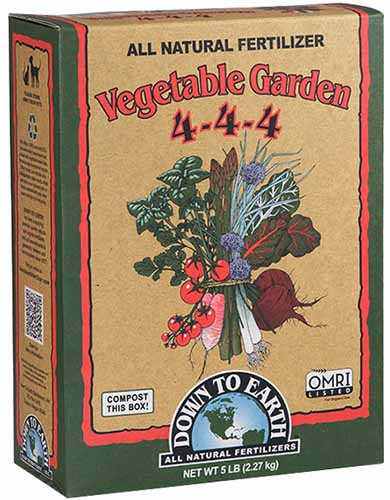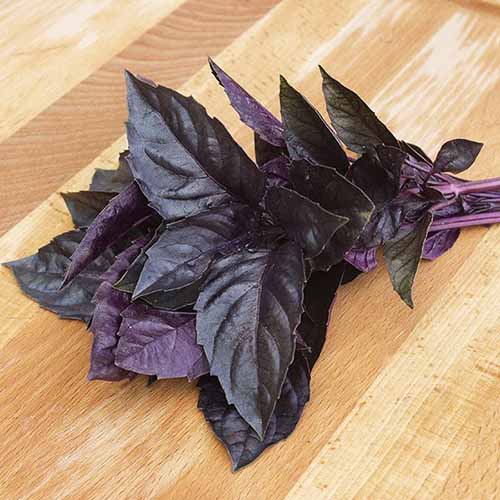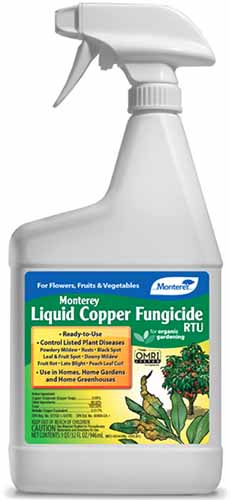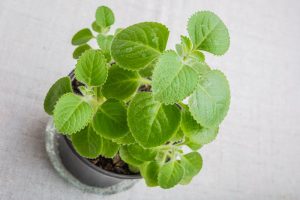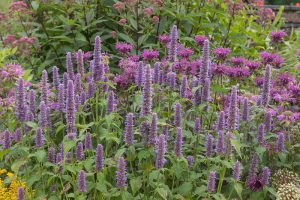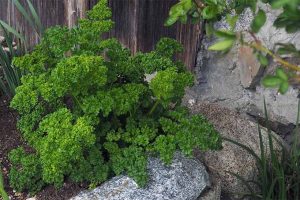Ocimum basilicum var. basilicum ‘Dark Opal’
There are few herbs and vegetables that are so gorgeous they could work solely as ornamental plantings. ‘Dark Opal’ is one such plant.
The deep purple, slightly ruffled leaves make an elegant anchor to green foliage or a surprising contrast to colorful flowers like marigolds.
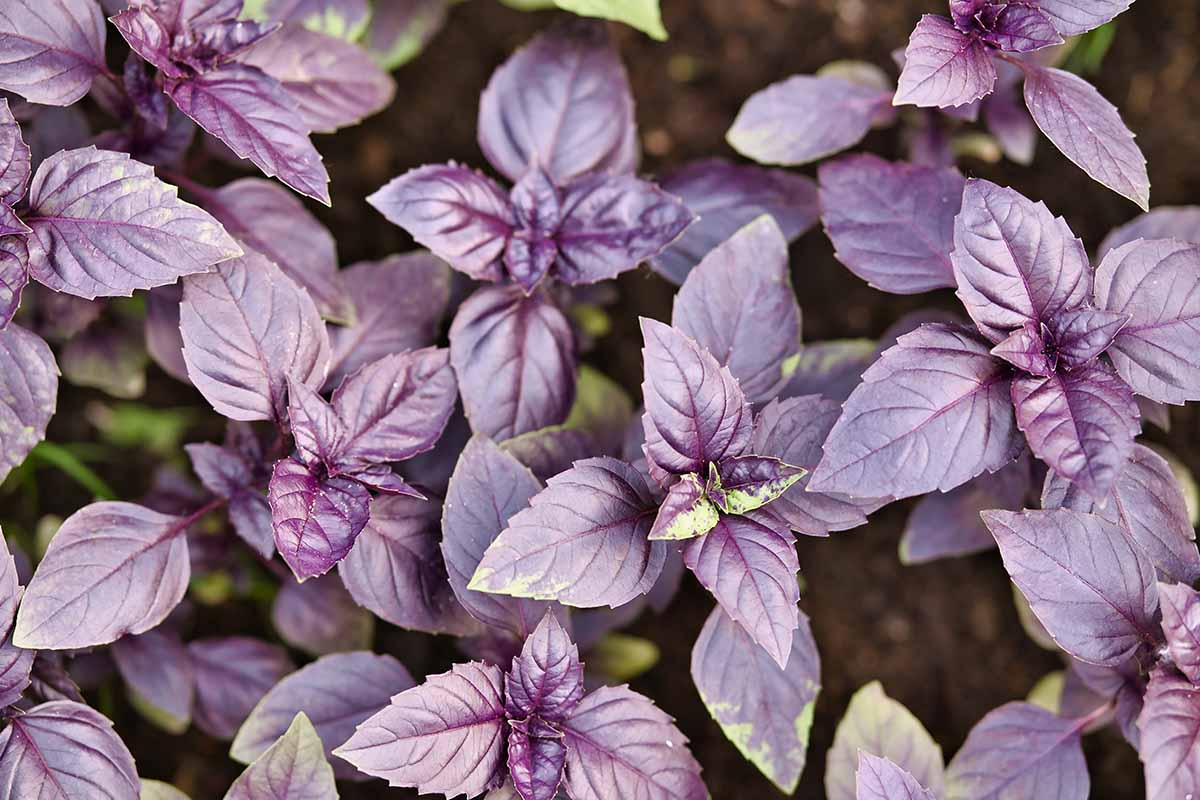
We link to vendors to help you find relevant products. If you buy from one of our links, we may earn a commission.
Of course, it’s not all about the looks. Yes, it’s a beautiful herb, but this sweet basil cultivar also tastes marvelous.
You’re not giving up any of the basil flavor you know and love when you grow this beauty.
Most of us grow basil as an annual, since the leaves tend to become tougher as the plant ages and because it’s only hardy in USDA Growing Zones 10 to 12.
You can learn more about how to grow basil in our guide. In this guide, we’ll set you on the path to ‘Dark Opal’ success.
Here’s what we’ll discuss:
What You’ll Learn
I’m sure you can’t wait to start enjoying your plants, so let’s dig in.
Cultivation and History
‘Dark Opal’ was bred by Dr. Joseph M. Lent and Dr. John Scarchuk, professors at the University of Connecticut’s Horticulture and Plant Breeding program.
The pair identified basil varieties from Turkey that had purple and green variegated leaves and decided they wanted to refine the plants to create a cultivar that was entirely purple, from stem to flower spike.
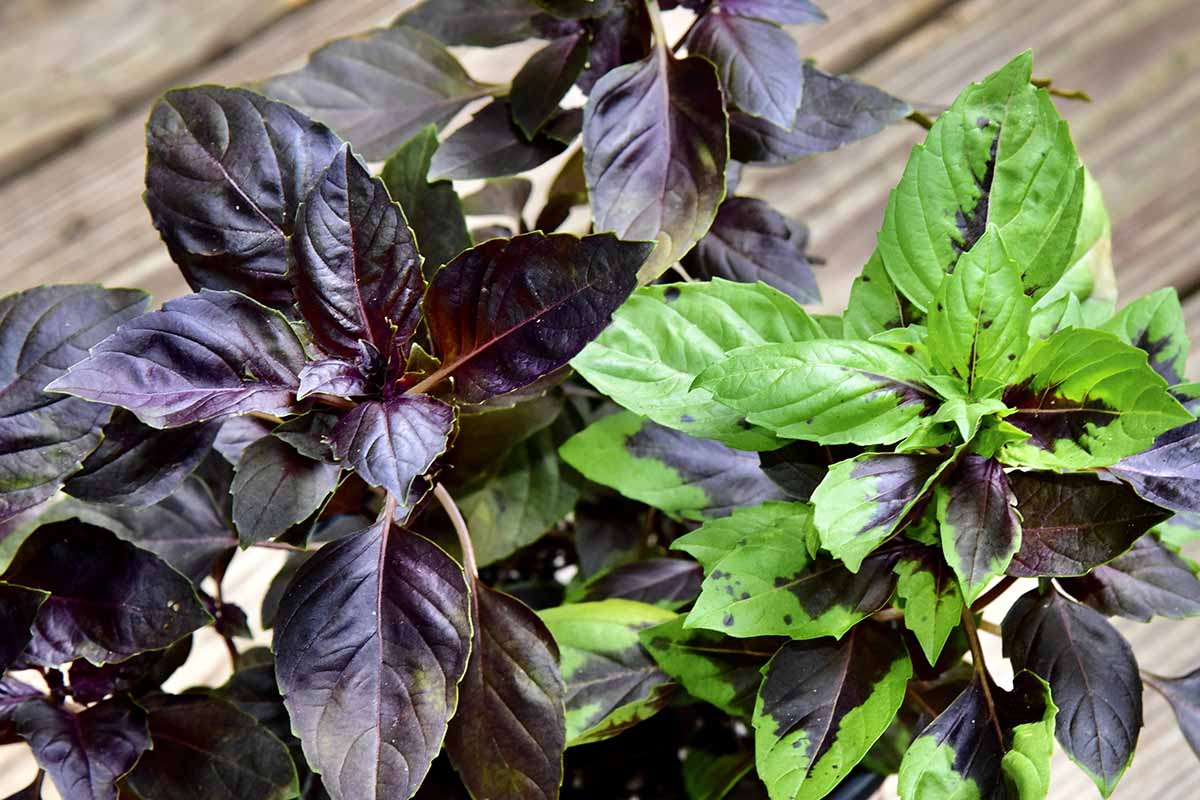
After a few years of selective breeding, they managed to create a uniformly purple plant with a pleasing flavor. It hit the market and was an instant smash hit with growers.
‘Dark Opal’ received the All-America Selections Bronze Medal and the All-America Selections winner in the Vegetable category in 1962, the year Ferry-Morse Seed Company released the seed to the market.
It wasn’t long before home growers fell in love with this cultivar, and the plant rapidly gained popularity in home gardens.
The vibrant hue is caused by the high level of anthocyanins, which is the same pigment that turns potatoes, eggplants, and tomatoes purple.
Plants develop this pigment as a way to help them resist environmental stressors like drought, pathogens, and hungry herbivores. We mostly like them because they look pretty, but purple plants can also have numerous health benefits.
The anthocyanins responsible for the purple coloration can also alter the taste. In the case of ‘Dark Opal,’ the leaves lack the bright, spicy notes of your average sweet basil (O. basilicum), though they have a broadly similar flavor.
It has a more subtle flavor that is earthier than sweet basil, a hint of lemon-lime, and an excellent crisp texture, making it perfect when you want a bit more subtlety than the licorice-heavy Thai basil (O. basilicum var. thyrsiflora).
It’s no slouch in the olfactory department, having a stronger scent than sweet basil. ‘Dark Opal’ is slower growing than many other basil cultivars and it takes about 90 days for the plant to mature.
‘Dark Opal’ Basil Propagation
There are multiple ways to propagate ‘Dark Opal.’
You can divide the plants you buy at the grocery store, take cuttings, or sow seeds – whether you harvest them from an existing plant or purchase packets from a nursery.
Growing from seed takes the longest, but they’re cheap and readily available, and you can produce lots of plants from one seed packet. If you go this route, consider succession planting so that you have a ready supply of ‘Dark Opal’ all summer long.
Cuttings require an existing plant and take a bit more nurturing, but they mature quicker than seeds.
Dividing grocery plants is the most expensive way to get started, but you’ll be able to harvest the leaves much more quickly than the other two methods.
Whichever method you land on, visit our guide to basil propagation for a comprehensive overview of the process.
How to Grow ‘Dark Opal’ Basil
As with other types of basil, ‘Dark Opal’ needs full sun to grow and look its best, but intense heat in the afternoon can bleach or burn the leaves.
A little afternoon shade is helpful, particularly in very hot climates. Just try to give it as much sun as possible since full sun helps the plant develop the best color.

Whether you choose to grow your plants in containers or in the ground, the soil must be well-draining. Amend garden soil with well-rotted compost or manure.
Choose a potting mix for container-grown plants that contains components like humus, moss, perlite, rice hulls, or vermiculite to improve drainage and aid water retention.
My personal preference is FoxFarm’s Ocean Forest Potting Soil Mix, which has bat guano, peat moss, earthworm castings, and fish meal. It makes all my houseplants and potted herbs happy.

FoxFarm Ocean Forest Potting Soil Mix
Pick up 12 quarts at Amazon.
While ‘Dark Opal’ will tolerate a fairly wide soil pH range, slightly acidic to neutral is best, with something between 6.0 and 7.5 being ideal.
When you’re transplanting seedlings or nursery starts, space them about six inches apart to allow for adequate air circulation which can help inhibit fungal diseases.
The soil or potting medium should be kept consistently moist but not wet or soggy. Imagine the texture of a sponge that you’ve wrung out really well. That’s what you’re aiming for.
If you’re growing your ‘Dark Opal’ basil indoors, make sure the plants receive at least six hours of direct sunlight and that the container you choose has drainage holes to allow the water to run out.
Keep in mind that if you keep your home cool, growth will be slow. These plants need temperatures of between 70 and 90°F to really thrive.
For that reason, if you’ve started your seeds indoors, be sure to wait until temperatures are consistently above 50°F before planting out.
The plants should be fed regularly. A mild, balanced fertilizer applied once a month is just right, whether you are growing in the ground or in containers.
I’m a fan of Down to Earth’s products because they’re made with natural ingredients and come in compostable boxes.
Their Vegetable Garden mix has an NPK ratio of 4-4-4 and is made from fish meal, alfalfa meal, and kelp, among other ingredients. Your ‘Dark Opal’ basil will love it.
Down to Earth Vegetable Garden Mix
Pick up one-, five-, or 15-pound boxes at Arbico Organics.
Growing Tips
- Plant in full sun, with afternoon shade in very hot regions.
- Provide well-draining soil or growing medium.
- Keep the soil consistently moist but not wet.
Maintenance
The only maintenance required when growing ‘Dark Opal’ is to pinch out the flowering tips. Follow the flower spike down to the first branch or set of large leaves.
Cut the spike off just above the branch or leaves.
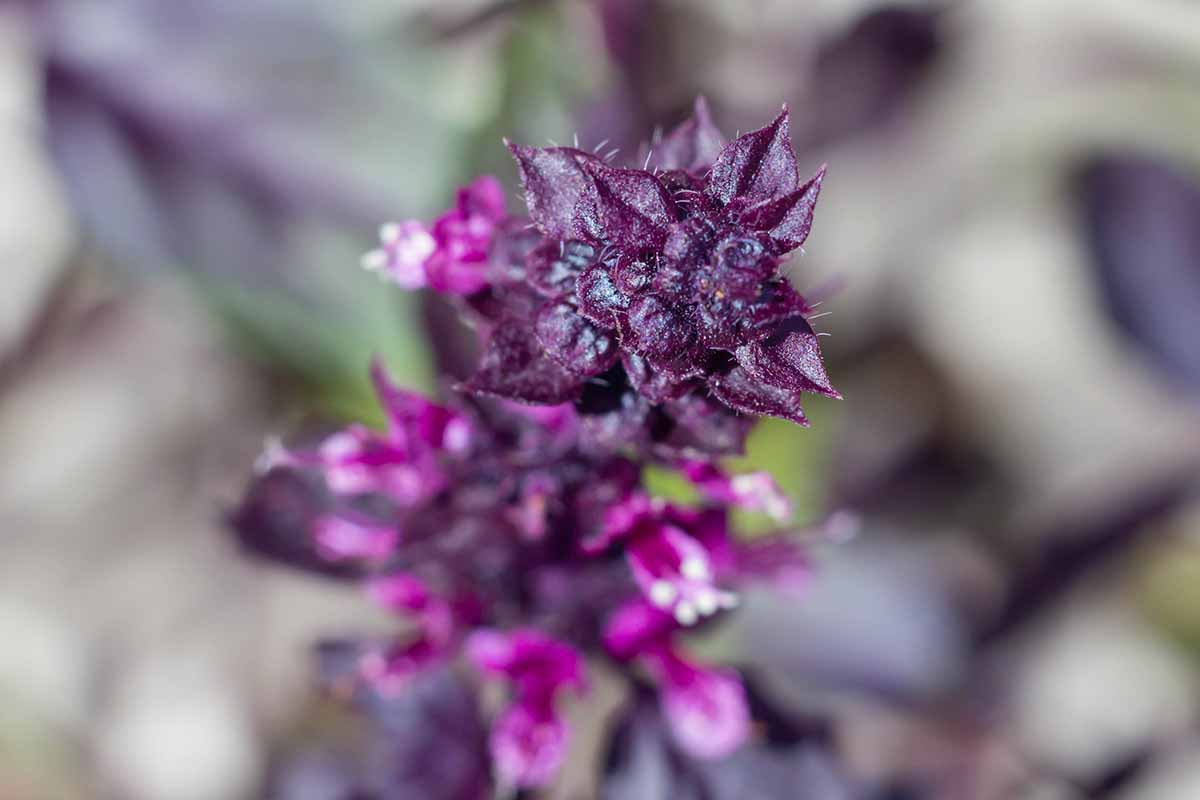
I’ve made the mistake of pinching off a flower spike higher up, and it always comes back and brings along some friends. You really have to cut low, or it will just branch out and regrow.
If you want to allow seeds to develop, don’t cut off the flower stalk, but know that the leaves will start to become more bitter.
You can also pinch the stems back as the young plant matures to encourage bushiness, but this isn’t required.
At the end of the growing season, when it’s time to let your herb go to the big compost heap in the sky, pull the entire plant out, roots and all.
You know it’s time if there’s a freeze on the horizon or if the plant keeps putting out more flower stalks than new leaves.
Where to Buy ‘Dark Opal’ Basil
‘Dark Opal’ is exceptionally popular, and you’ll find it just about anywhere basil seeds are sold.
For example, High Mowing Seeds carries packets of organic seeds of this popular ornamental herb.
So does True Leaf Market, which has many quantity options. Bring home a one-and-a-half-gram packet or an ounce-, four-ounce, pound-, or five-pound pack.
If you want to try a bunch of different types of basil, including ‘Genovese,’ cinnamon, lemon, lime, and large leaf, visit Botanical Interests for their Six Basil Blend in either a gram or three-gram pack.
Managing Pests and Disease
I find this herb to be fairly problem-free because I generally grow it as an annual. Basil is technically a perennial, and if you grow it as such, you’ll probably encounter more issues.
Insects
Aphids, Japanese beetles, slugs, snails, and whiteflies will all feed on ‘Dark Opal.’
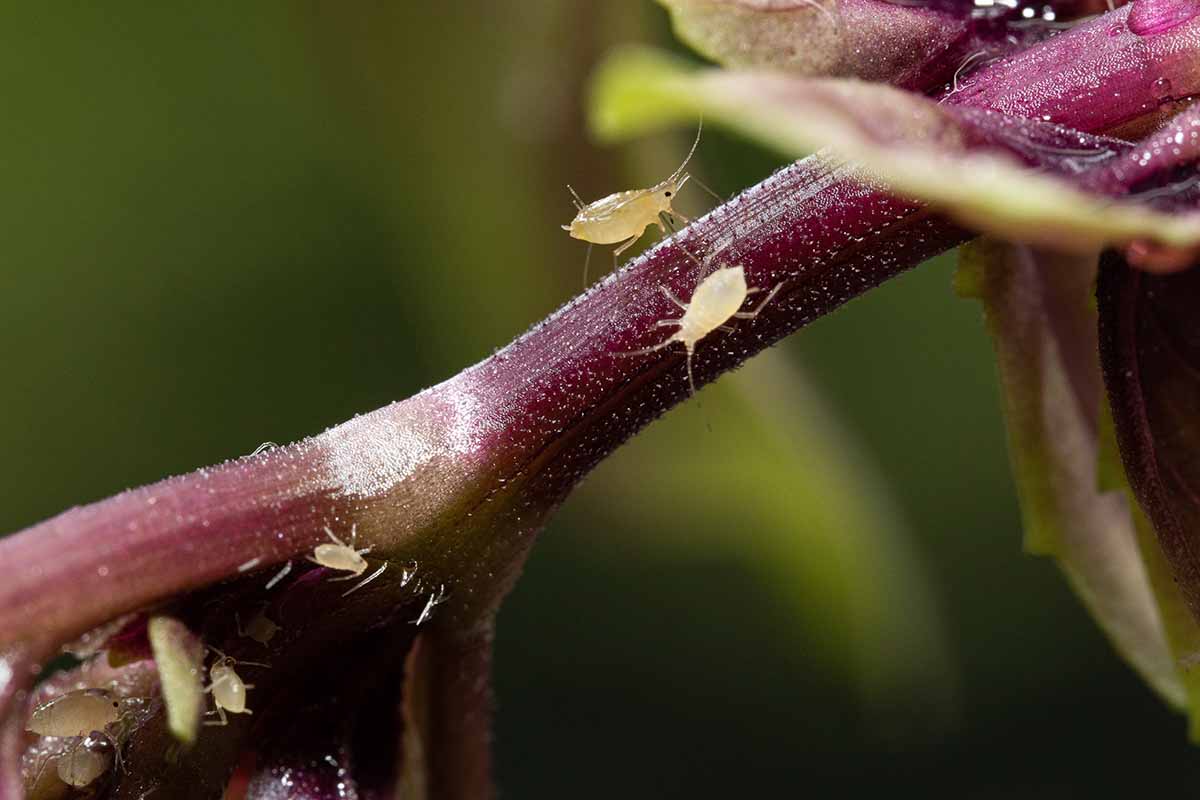
Aphids are oval-shaped and whiteflies are tiny fly-like insects in a white or gray hue. Both suck the sap from the plant and cause damage to the foliage.
If you notice the presence of either of these you can knock them off the plant with a strong stream of water from the hose.
Spray with some neem oil or insecticidal soap if a weekly hosedown isn’t enough.
Learn more about how to deal with aphids and whiteflies in our guides.
Japanese beetles (Popillia japonica), on the other hand, aren’t so easy to address. Whether the larvae, pupae, or adults are around, they will devour herbs, vegetables, and ornamentals with equal gusto.
Netting, insecticidal soap, beneficial predators, and beneficial nematodes will all be a part of your Japanese beetle defense strategy. Our guide explains what you need to know.
Finally, you’ve probably dealt with slugs and snails before. Use your favorite nontoxic bait or check out our guide to dealing with these marauding mollusks for other strategies.
Disease
A few diseases will attack basil plants and unfortunately they can take hold rapidly and prove deadly.
Let’s start with the one that can kill your seedlings before they even have a chance to mature.
Damping Off
I really hate damping off. Your seedlings are coming along nicely, and you start to dream of all the dishes you’ll be whipping up topped with dramatic ‘Dark Opal’ leaves, and then tragedy strikes.
Once your plant is infected with damping off, there’s nothing you can do. Your seedling is going to die. It’s enough to have you swearing off gardening.
This soilborne disease is caused by fungal species in the Fusarium and Rhizoctonia genera, and species of water molds in the Pythium genus.
When it strikes, your plants will develop a water-soaked lesion at the base of their stems and then quickly collapse. Sometimes the tops die entirely, and sometimes they’re just incredibly stunted, but they will never develop into healthy specimens.
Prevention is the only strategy in dealing with this disease. A big part of prevention is using clean soil, tools, and containers. Learn all about damping off in our comprehensive guide.
Downy Mildew
Downy mildew is a common disease throughout the garden. In basil, it’s caused by the oomycete Peronospora belbahrii. This pathogen is a recent immigrant to the US, arriving in Florida in 2007, but when it strikes, it’s bad news.
At first, it may seem like your plant is just a little bit sad, with some yellowing foliage, slowed growth, and maybe even some faint gray fuzz on the undersides of the leaves.
As it progresses, the entire leaf turns yellow, and the spores turn dark gray or purple as they become much more prominent.
At this point, your plant is in deep trouble.
Fortunately, ‘Dark Opal’ and other purple cultivars are less susceptible to severe infections, but you still don’t want it causing problems in your herb garden.
The best thing to do is avoid downy mildew in the first place.
Good air circulation, watering at the soil level, cleaning up any fallen plant debris, watering in the morning so plants have time to dry during the day, and purchasing seeds and starts from reputable sources are all important tactics.
If it’s too late for prevention, you’ll need to spray the leaves and stems with a fungicide.
Liquid copper, like Monterey’s 32-ounce ready-to-use spray, which is available at Arbico Organics, is a smart bet.
Use it every two or three weeks until the symptoms subside.
Fusarium Wilt
I stopped buying sweet basil plants at the grocery store because so many of them were plagued by fusarium wilt.
Plants infected with this disease, caused by the fungus Fusarium oxysporum f. sp. basilici, start to wilt once they’ve reached about their mature height.
If you look at the bottom of the stems, you’ll see brown streaks. As the disease advances, the leaves might start curling and turning yellow, and sometimes present with brown splotches.
If conditions are very humid or the soil is extremely moist, you might even see pinkish-orange spores.
Sadly, there’s no cure, and if this pathogen is present in your soil, it can stick around for over a decade. If your ‘Dark Opal’ is infected, all you can do is dispose of the plant and avoid growing basil in the same soil for at least ten years.
Harvesting
You can harvest the leaves individually or cut entire stems as you need them, but don’t take more than half at a time, to allow the plant to keep growing.

You can pull the leaves off by hand or snip them with scissors.
Preserving
Dried basil is a staple in most spice cabinets. ‘Dark Opal’ is milder than most green leaf types, so it’s worth keeping around for those dishes that just need a hint of flavor.
You can learn about how to dry basil in our guide.
You can also freeze the leaves. First, rinse them well and allow them to dry. Then, lay them out in a single layer on a baking sheet and put this in the freezer.
Once the leaves are frozen solid, toss them in a baggie and seal all the air out. Put this back in the freezer.
Recipes and Cooking Ideas
You can use ‘Dark Opal’ in the same way that you use other types of basil.
Purple pesto is a vibrant surprise on the kitchen table, and the leaves look fabulous with red tomatoes, in strawberry lemonade, and marinara.
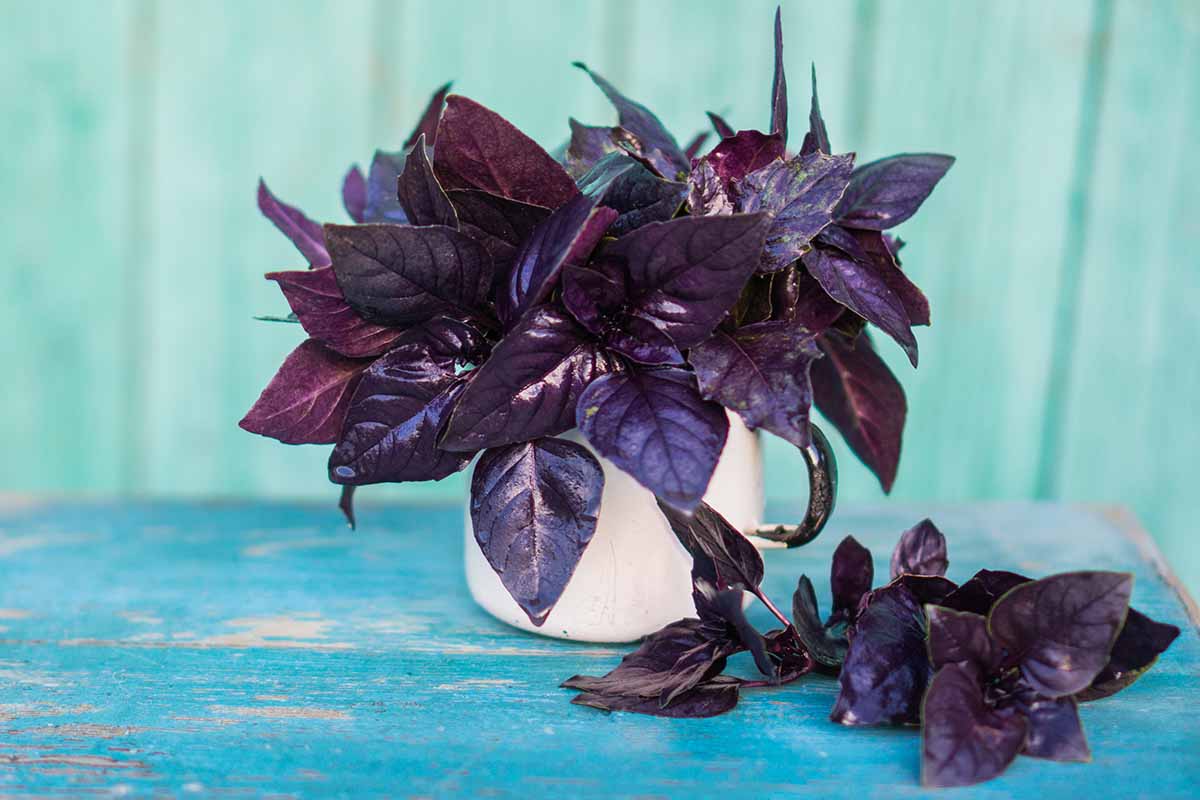
Or how pretty would the purple leaves be in strawberry, lemon, and basil infused water? Sound good? You can find the recipe from our sister site, Foodal.
Quick Reference Growing Guide
| Plant Type: | Perennial herb, grown as an annual | Foliage Color: | Purple |
| Native to: | Cultivated variety | Tolerance: | Salt |
| Hardiness (USDA Zone): | 4-9 (annual), 10-12 (perennial) | Maintenance: | Low |
| Season: | Summer | Soil Type: | Loose, rich, loamy |
| Exposure: | Full sun, afternoon shade | Soil pH: | 6.0-7.5 |
| Time to Maturity: | 90 days | Soil Drainage: | Well-draining |
| Spacing: | 6 inches | Companion Planting: | Borage, marigolds, mint, nightshades |
| Planting Depth: | 1/4 (seed), depth of root ball (transplants) | Family: | Lamiaceae |
| Height: | 18 inches | Genus: | Ocimum |
| Spread: | 10 inches | Species: | Basilicum |
| Water Needs: | Moderate | Variety: | Basilicum |
| Common Pests and Disease: | Aphids, Japanese beetles, slugs and snails, whiteflies; damping off, downy mildew, fusarium wilt | Cultivar: | Dark Opal |
‘Dark Opal’ is a Real Gem
It tastes incredible, is beautiful enough to grow purely as an ornamental, and is packed with antioxidants. What’s not to love about ‘Dark Opal’ basil?
How will you use your plant? Is it going to add color to the garden? Or a bit of flavor to your dishes? What’s your favorite recipe? Share with us in the comments section below.
And for more information about growing basil in your garden, check out these guides next:

